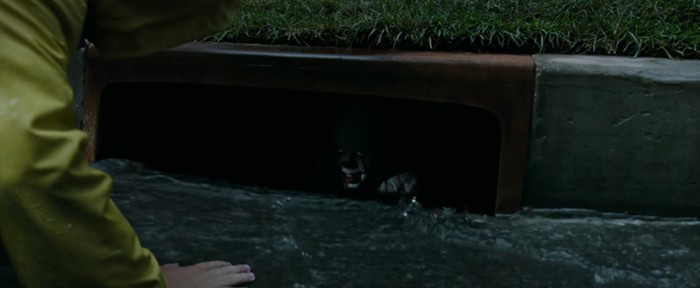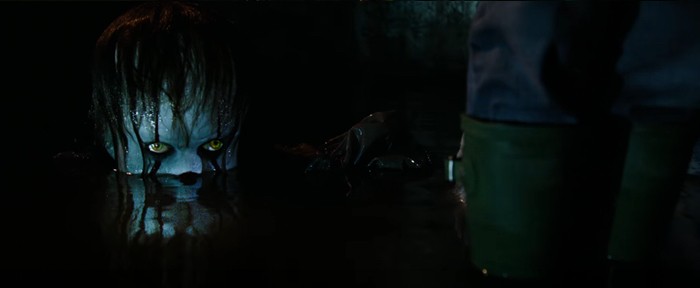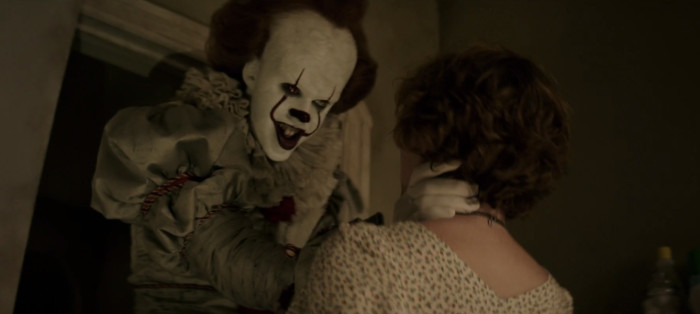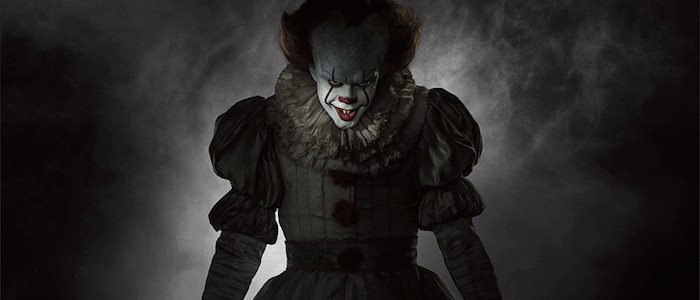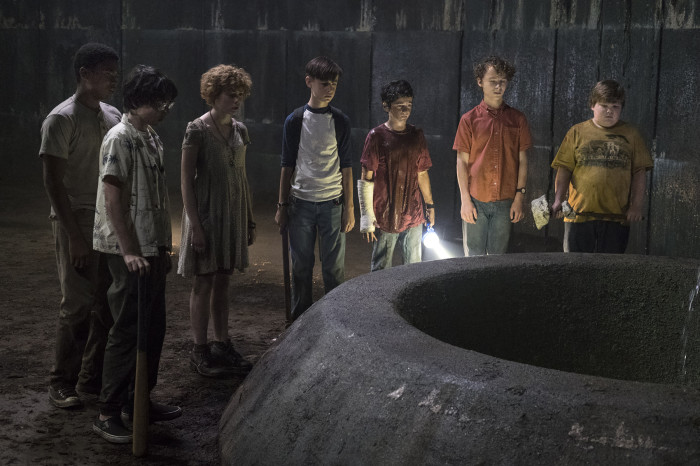How 'It' Reinvents Pennywise The Clown For A New Generation
Pennywise the Dancing Clown is an unlikely horror movie icon, mainly because he has yet to appear in a horror movie. Many people know him from Stephen King's classic horror tome It. Many more know him from the 1990 TV miniseries adaptation, where he was played so memorably by the great Tim Curry. So, how does a 2017 big screen version of It take on a character so familiar (and so frightening) to so many people? Simple: you reinvent him/it from the ground up.
With this new version of It, director Andy Muschietti and actor Bill Skarsgård deliberately set out to create a version of Pennywise that feels nothing like Curry's performance. In many ways, it looks nothing like the version described in King's work, either. This Pennywise (actually the favorite form of an ancient, shape-shifting monster that preys on children) looks to reinvent the "scary clown" for a new generation of moviegoers.
When I visited the Toronto set of It last year, I saw firsthand just how different this Pennywise will be...and courtesy of the filmmakers and Skarsgård, learned just how this unique take came into being in the first place.
Designing Pennywise
While Pennywise remains the dominant face of "It" in the new movie, this creature is a shapeshifter. Like its book counterpart, Pennywise is just one face plastered upon an endless series of horrors. And with the change in time period (this It takes place in 1989 instead of 1957) comes a change in what those horrors will look like. Producer Barbara Muschietti explained:
He's still very much the glamor creature, and he represents the '80s fears of these kids, which again, are a lot less iconic than the book, although there are winks to those '50s fears. But he's still very much a shapeshifter who basically tunes into a fear and will augment it and present it to you when you least expect it.
And while Pennywise is the character most commonly associated with this tale, she said that they deliberately set out to limit his time onscreen as much as possible to give his appearances more impact:
He appears as Bob Gray [the alternate name for Pennywise] in very specific moments. We see him as little as we possibly can. That's what we tried to do. But I think everybody will get their fair share of Pennywise if that's what they're going to the movie for.
Actor Bill Skarsgård drew from the mythology of King's novel and realized that this ancient being presumably found a skin that's worked for the past few centuries and decided to stick with it:
So you could assume that 5,000 years ago it would've been something that terrified people at that time, maybe a spirit or something like that. I think in our version, Pennywise is something that's maybe been around and maybe drew the inspiration from a real person, in Bob Gray or whoever he was, and created this version of a clown that fit the 19th century, judging by the clothes and appearances and then he really enjoyed that version and is stuck with it. So, that's kinda how I rationalized to see who or what Pennywise is in terms of the form that he is, where he comes from, and who he is.
Unlike the Pennywise from the novel and the 1990 miniseries, who was depicted as Bozo-type, the kind of clown commonly associated with television and birthday parties, this version feels a bit...older. Barbara Muschietti described him as "the ancestral clown...not of any particular era." Pennywise is "beyond, from above, the past and future." Plus, she wryly noted that Americans seem to be alone in finding more traditional circus clowns terrifying:
We were talking with other journalists the other day from the international press and they were saying clowns weren't seen as scary in other parts of the world, they're more pathetic. In the U.S., they're terrifying and they're being made even more terrifying by a couple of loonies who are wandering the forest. We had nothing to do with that and I hope that ends soon because it's freaking me out.
Director Andy Muschietti (for the record, Barbara's brother) was a bit more blunt about this shift in Pennywise's appearance:
Yeah. Well, the fact that this entity has been around for thousands of years... I don't dig the 20th century clown. I think it looks cheap, and it's too related to social events, the circus and stuff, but I'm more aesthetically attracted to the old time, like the 19th century clown. And given that this guy has been around for centuries, I wondered to myself why, why not, have an upgrade that was 1800s.
With this "upgrade" in mind, Andy Muschietti started drawing and his early versions were close to what we see on screen:
I had a sketch. One sketch. It was like a baby. It was like a Gerber baby. With something very off, because his eyes were wide-eyed, like slightly apart. [...] And then, to be honest, it didn't evolve much from that point. And then the Pennywise you saw today [on set] is special because his hair is crazy, but the rest of the movie is different. I'm playing a little bit with his mood, and his mood sometimes in terms of the hair. There's like two [hairstyles] maybe. But the official shape is more like a weird baby.
Despite the differences, Barbara Muschietti said Andy Muschietti continued to be inspired by King's original descriptions:
He started the design, then we started working with other concept artists to finesse those ideas. Then Bill [Skarsgård] came onto the picture so his physiognomy helped a lot. Then our prosthetics department got involved to mimic what those concepts were. Again, I think King's descriptions of Pennywise in the book were very much in mind.
Casting Pennywise
With this reinvented Pennywise on paper, it was time to find an actor to fill the ancient clown clothing. Barbara Muschietti noted that actor Will Poulter, who was attached to play the role when Cary Fukunaga was attached to direct, did enter the conversation:
He was on the table but there were, to be completely honest, there were scheduling conflicts because he was on The Maze Runner. When we started, we started seeing people right away and the moment Bill popped up, I think we knew it was for us.
As seems to the to be the general gist of their dynamic, Andy Muschietti was far more blunt about this matter than his producer/sibling:
And I remember I was sort of interested in Will Poulter. He was part of a previous approach, and I had a meeting with him. He wasn't very interested in doing it at that time. And also his career was starting to take off and I think he got a little scared.
So it was back to the drawing board. Barbara Muschietti noted that they auditioned literally hundreds of people for the role and "really went through the spectrum of actors." No one was off limits: men, women, young, old, known, and unknown. When jokingly asked if Tilda Swinton auditioned, she said no...but only because she wasn't available. ("But of course, we all thought about it.")
And then, enter Bill Skarsgård. Said Andy Muschietti:
I was basically hoping for someone who would surprise me in any way. I had a pre-existing criteria of someone who looked childlike, and that's where Bill came in [...] So to be honest, I saw a lot of people, but there was very few, a small short list, and Bill was on top of it.
Barbara Muschietti elaborated further:
We read the novel when we were teens, we saw the miniseries much later in the game, so Tim Curry's performance is extraordinary, but that is not necessarily what we link to Pennywise immediately. For us, Pennywise is the Pennywise in the book, which is quite different. I think Bill went for that and he did an amazing, amazing performance and we gave him several tests. Again, because he's a shape shifter, we wanted to make sure that he could play in different grades, right? And he did. he's amazing. And what's even more amazing is that he kept the character very unpredictable, and that's what scares us the most, when you don't know what way he's going to go
To prepare for his audition, Skarsgård did his homework by reading the book and watching the miniseries, noting that there are an infinite number of Pennywises – Tim Curry's onscreen version and the countless interpretations invented by millions of readers over the decades. So it was important for him to not mimic Curry's performance in any way and embrace the other possibilities:
I watched the miniseries and really appreciated Tim Curry's take on it, but now I had to do something completely different. Obviously, that's not something you study. I wouldn't see the point in making a film that's similar to the one that's already been made, so I didn't try to think too much about that. I just worked really hard to create my own interpretation of Stephen King's character.
While Pennywise would continue to evolve after Skarsgård was cast, he said he came into the audition with a fully realized version of the character. And since Andy Muschietti embraced his take, they ended up on the same page for much of the production:
Obviously, everyone who went in for it had a character. It's such a full-on character, you have to come up with, even in the casting process, a very particular character who you think is right. He responded to whatever I came up with. So even going into production, this was a guy who responded to something that I thought the character would be like. We had that connection. We both had similar ideas about what we wanted to do with the character. That started in the casting process, but it was very true throughout the whole production. I don't think we ever really argued about anything about the character. I think we were always on the same note about what we wanted to do. That's not as common as you'd hope in actor-director relationships.
Pennywise Prepares
One recurring theme throughout our set visit was that this team was not remaking the miniseries – they were making a new adaptation of the original novel. Skarsgård took that to heart with his performance and tried to find a voice for his character that would be unique to him. However, it wasn't until he saw himself in make-up and costume that everything clicked:
I play around with a lot of different versions of what this thing might sound like. The voice had changed a lot from the first time I had auditioned. I explored different versions of it, what would resonate the most with the audience. It was really when we did the full make-up test and see what the character would actually look like...it's a very abstract way of preparing for something when you have no idea what he will look like. I didn't know what the make-up would look like, I had no idea what the prosthetics would look like. Then we started exploring different things and I saw different prototypes of what he might look like and I started working with that. My first test with the prosthetics and make-up was where I saw what the character would actually look like with me in it. That's something I needed to explore to [discover] what this thing would sound like.
And while Skarsgård's voice will not be tinkered with in any way during post-production, Andy Muschietti said that this version of Pennywise adopts several different voices. He adapts to whatever situation he's in:
It's a different approach, but he's not sticking to one voice. He has different personas. Because it's a character that is based also on unpredictability, so he has this stagey persona, the more clowny appearance, but then in certain scenes when he turns into this other, which is harder to grasp, and that's the "other," you know, the "It." And he has a different tone, he has a deeper voice, and a different feel to it.
Barbara Muschietti described Pennywise as "definitely evil and the incarnation of the worst of people's fears." He exists "to represent fear" and can take on any qualities to achieve his goals. "That is his purpose," she said, noting that this version of the character "is a different, more active Pennywise" who enjoys the hunt:
This Pennywise plays with his food. He taunts them, and that is of course very amusing but very disturbing at the same time, and very scary.
To bring this creature to life, Skarsgård looked inward:
I only have my own senses to go on so I wanted to make something that I would be scared of [laughs]. So an important thing for me in terms of preparing and creating the character was thinking "What are the things that I would find really unsettling?" And then explore that. Your own kind of fears and what you find disturbing and amplify that in terms of the performance. Essentially, what you'll end up seeing in the film is my own deepest fears embodied in this character [laughs].
But he also returned to King's text, with one moment helping him understand why "It" continues to take on the Pennywise form:
Obviously, it's an extremely abstract character because the character is an entity taking the shape of a clown. I had to first figure out what the entity was and what the thing was that is taking the shape of the clown. The second step is to create the clown itself. I didn't want the clown to be completely separate from the entity, right? I wanted "It" to really shine through Pennywise as opposed to just Pennywise being the clown. So a lot of what the entity is I wanted to be in the background of who Pennywise is at all times. There's a line in the original book where it goes something like "the clown was its favorite form." It really enjoyed being the clown. He preferred to take the shape of the clown. Obviously, that opened ways of thinking. Why does he prefer being the clown? But also there is this sense of enjoyment. The entity that is "It" is enjoying being the clown. There were a lot of abstract ways to look at it. I tried to take all of those in consideration when I embodied the character.
King's thick, dense novel was especially helpful since the 120-page-screenplay version of Pennywise doesn't offer an actor much to chew on. That's by design, of course, to keep "It" mysterious to the audience, but it required some extra homework for Skarsgård:
I had to make Pennywise anything but mysterious because I need to understand him as well as I can. I read the book and I took a lot of notes on anything that described Pennywise in any way or "It" in any way. A lot of great chapters. There's one chapter in particular where "It," the entity "It," is the narrator and you hear his thoughts and what he thinks like. So there was this huge source material to go from. What is this thing? Why is he here? What does he think like? What does he like? What doesn't he like? I could use all of those things to come up with my own version and my own interpretation of what "It" is and also what Pennywise is. And then using all of that with my own ideas and my own thoughts and conclusions, I could apply them to the more limited version in the script.
Pennywise on Set
You may recall that many It fans, both of the book and the miniseries, were unhappy with the first official photo of Bill Skarsgård as Pennywise the Dancing Clown. It turns out that Skarsgård was none-too-happy about it either:
So, it's weird because I hadn't even begun shooting it yet when that was released. The tactic behind it was the studio wanted to be in control of the images being leaked...It was released the day before we started shooting because my first day of shooting was something that someone would potentially sneak a photo of. So, that was weird. I didn't like that people saw what the look was before I'd even [started] building the character, you know? For actors, I think, and filmmakers...before it's actually released, it's still yours, you know? In the sense that no one has seen it, no one has an opinion on it, it's still your thing that you're working on and exploring and it's a nice feeling that it's not out in public. Then, once you finished it, there's an excitement for when it is time and when you're ready and separated from the thing and go, "Here!"
While the jury is still out on how Pennywise will look and feel in the finished film, I can personally attest that he looks far better in person than he did in those early promotional stills. While visiting the set, we were able to watch Skarsgård film one scene in-character and it's a moment glimpsed in the first trailer. The young heroes of the film, the "Losers' Club," watch a slideshow, only for the projector to go haywire and Pennywise to emerge from the screen to torment them.
But there was no projector on this set. It wasn't even a living room. The kids weren't even there. It was a green screen and Skarsgård was peering through a square hole standing in for the projector screen. He will be digitally composited into the actual scene, which has already been shot on a real set with the kids.
It's a patently ridiculous scenario: a man in a creepy clown costume standing against a brightly lit green background, staring through a green window, surrounded by men and women adjusting lights and prepping cameras. Filmmaking is a silly thing when you glance just off the lens.
Even under these circumstances, this new Pennywise was certainly intriguing. The costume, faded almost to sepia, was more disconcerting in-person. The clown make-up is creepy, but it's the more subtle prosthetics that give his head an unnatural shape that struck me as more unsettling. Skarsgård is taller and lankier in real life than he looks in any images, which certainly adds to the menace of the character.
We didn't hear him speak in this scene, but we did hear Pennywise grunt and squeal and laugh and groan — each take brings a different uncomfortable noise as he slithers through the "projector screen" toward his young victims. It's a jump scare waiting to be born in the editing room — Skarsgård's Pennywise strikes a pose, listens for a cue ("Stanley!" surely referring to the character of young Stanley Uris) and then launches forward toward the camera.
As we watch filming, Skarsgård brings something a little different to each and every take, some of it creepy, some of it gross, some of it darkly amusing. As he told us:
We did everything in so many different ways. I don't think I could have done it if I didn't trust what Andy liked. He would say "This is great, I'm really responding to this" and I would just continue to do it, whatever it was. Essentially, it was the most weird, scary and disturbing thing we could come up with. It was important to me that there was something absurd about the character. Something inexplicable. Why is he doing this? Unpredictable absurdity to the character that will catch people off guard. This kind shock factor where you never know what this guy is going to do next. You have no idea what he'll do or how he'll do it. There's no way of predicting his behavior. Obviously, that meant there was a lot of chaotic scenes and weird explosive things that we did. We'd explore it. If I didn't have that trust in Andy, I don't think that I'd ever be able to do it. You need to when you do something that out there.
Before the day was out, we'd get to see exactly where an evil shapeshifting clown calls home.
Pennywise's Lair
Like in the book and miniseries before it, the climax of It takes place in the sewers beneath Derry, Maine, where Pennywise has set up shop. And since filming in actual crumbling New England sewers would be counterproductive to say the very least, the soggy labyrinth that "It" calls home has been recreated on a Toronto soundstage. And it's eerily convincing.
After donning boots, we ducked into the muddy, watery tunnels, guided by a crew member who knows where he's going (and knows that this series of tunnels have been built to look confusing rather than actually be confusing). The walls are constructed from wood, but they've treated to look like old stone – they only give themselves up when you touch them. But touching them doesn't sound like the best of plans. Even knowing that we're walking through an artificial film set, the whole set is disgusting and grim. Your mind supplies the smell. The various false tunnels and dead ends supply the illusion of being lost
We sloshed through the tunnels, eventually arriving at the grand finale: the cistern. Pennywise's basecamp. In the middle of this murk, surrounded by deep puddles of water and muck, is an ancient wagon, looking like something you'd see from a traveling theater company use in a movie set a few centuries ago. It's faded and worn, but the words on the front door, written in bold font, are clearly legible: "Pennywise the Dancing Clown." We are told that the front door of the wagon is rigged to explode open, allowing Pennywise to make a sudden entrance.
But the wagon isn't even the highlight of this huge set. That would be the pile on top of the wagon, stretching up high into the air. Right now, the pile is 30 feet tall. When the VFX team is finished with it, it will be 80 feet tall.
The pile consists entirely of children's clothes and toys.
Upon closer examination, the clothes and toys at the bottom of the pile are rotten and brown with age – relics of a distant era. As the pile grows higher, the clothes grow newer and fresher, still showing off their colors. In one image, you can see Pennywise's long history, his murder sprees over the centuries, by the souvenirs he has piled here. It's the creepiest thing we saw on set all day, a genuine triumph of production design. It truly is a lair fit for one of the horror genre's most iconic monsters.
As we exited the set, a crew member passed by our group, lugging a soggy corpse behind him. "Don't mind me," he said with a smile. Could you ask for a more appropriate capper to a tour of an evil clown's underground lair?
***
It opens in theaters on September 8, 2017.

